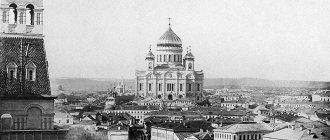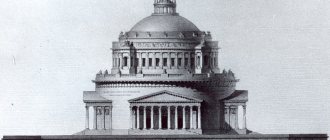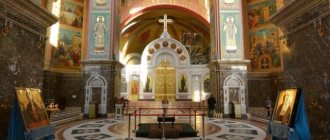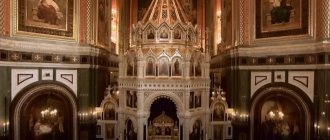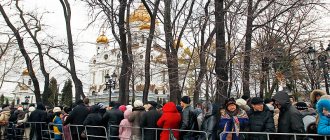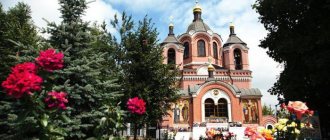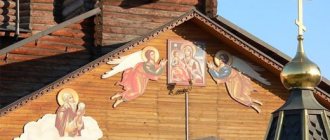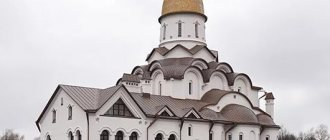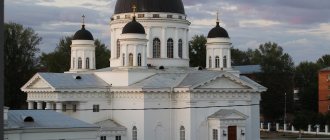Leaving Moscow, Napoleon was in despair.
The brilliantly started Moscow campaign ended in failure. Abandoning the remnants of the once huge army, the French emperor fled to Paris with a squadron of guards. The war against Russia was lost. In honor of the victory over the enemy and the expulsion of the French from the borders of the Fatherland, Alexander I issued the highest manifesto on the construction of a church in Moscow in the name of the Savior Christ.
This began the long and complex history of the Cathedral of Christ the Savior. “At the end of 1812, when Napoleon was expelled from Russia, Victory Day was proclaimed, which was celebrated until 1917. In the same manifesto on the occasion of the victory over Napoleon, the idea of creating a temple was formulated “in commemoration of gratitude to God’s providence, which saved Russia from threatened destruction,” says Doctor of Historical Sciences Vladimir Fortunatov.
A huge project and a missing budget
An international competition was announced, in which such famous architects as Voronikhin, Quarenghi, Stasov participated. But Emperor Alexander I liked the project of an unknown young artist of Swedish origin, Karl Magnus Witberg. The emperor was struck by the scale and grandeur of the architect's plan, who, by the way, was a high-degree Freemason. It was a project for a huge temple, three times larger than the current one, with a pantheon and a colonnade of 600 columns. The cathedral was supposed to be decorated with captured weapons captured in the Patriotic War.
They were going to build the cathedral on Sparrow Hills, where the main building of Moscow State University is now located. This could be the grandest temple in the world. The temple complex would include an underground temple for round-the-clock memorial services for all those who died for the fatherland. Above it should have risen a temple decorated with many statues in the name of the Transfiguration of the Lord. The structure would be crowned by a round upper church in the name of the Resurrection of Christ. The height of the entire structure is 237 meters, the diameter of the main dome is more than 50 meters. The scope of the colonnades in the project was more than a kilometer. On their sides, it was planned to build two triumphal columns 106 meters high, cast from cannons captured from the enemy.
The ceremonial laying took place on October 12, 1817. In front of a huge crowd of people - almost 400 thousand people - a plaque with a memorial inscription was placed in the prepared granite stone. Money for construction was collected by the whole world; 16 million rubles were allocated from the treasury - a gigantic amount for those times. However, the construction was never completed. They said that due to soil subsidence...
“In reality, the entire construction budget was lost. Therefore, the chief architect Karl Witberg and the company were put on trial, says writer Alexander Myasnikov. - And he was sent to Vyatka, into exile. Everything was taken from him. Everyone involved in construction was put on trial for the disappearance of money. Everyone said that Vitberg could not do this, he is a very decent person, but this was the situation.”
History of creation
The idea of building a temple arose in the winter of 1812 at one of the meetings of the “Conversation of Lovers of the Russian Word” society, chaired by the statesman and poet Gabriel Derzhavin.
The proposal was submitted to Tsar Alexander I, and a few days later, on Christmas Day 1812 (December 25, old style), a manifesto appeared signed by the sovereign, which said: “In preserving the eternal memory of that unparalleled zeal, fidelity and love for the Faith and to the Fatherland, with which the Russian people have exalted themselves in these difficult times, and in commemoration of Our gratitude to the Providence of God, which saved Russia from the destruction that threatened it, We set out to create a church in the name of the Savior Christ in Our Mother See of Moscow...” The manifesto was widely supported by the most various representatives of Russian society. Soon an international competition was announced for the design of the temple. Alexander I wanted it to not only immortalize the history of war and salvation. The “mission of the Russian people” should have been reflected in stone form. And such a project was found. Unexpectedly for many, the 28-year-old architect of Swedish origin, Carl Mangus Witberg, won. His project stood out from the rest in scale - the height of the temple was supposed to be 237 meters, almost two-thirds higher than St. Peter's Cathedral in Rome. It included a colonnaded square over 600 meters long and triumphal columns cast from captured enemy cannons. Having assessed the project, Alexander I said: “You made the stones talk!”
In 1817, in the presence of almost the entire population of Moscow at that time - about 400 thousand people - the first stone was solemnly laid on Vorobyovy Gory. And if this project were destined to come true, today we would be able to see the temple from anywhere in Moscow. The vigorous pace of construction, taken at the first stages, soon slowed down noticeably due to problems with infrastructure, and after the death of Alexander I in 1825, work stopped altogether. Nicholas I, who ascended the throne, was not sensitive to his brother’s “mystical revelations” and stopped the project. According to the official version, the land on which the temple was built was unsuitable for construction. The architect himself, who managed to change his name from Karl Mangus to Alexander Lavrentievich, was convicted of embezzlement and exiled to Vyatka. Historians are still arguing about whether he was guilty or not. However, the Alexander Nevsky Temple, built by Vitberg in Kirov in memory of the emperor, until its destruction in the 20th century, testified in favor of the architect more eloquently than any other arguments.
Nicholas I did not abandon the idea of construction, but decided to consider new projects, among which the one proposed by Konstantin Ton, the architect of the Nikolaevsky Station (now Leningradsky), the Grand Kremlin Palace and other buildings in Moscow and St. Petersburg received special attention. The project was made in the Russian-Byzantine style and, with some reservations, represented the temple that can be seen today on Volkhonka. Chertolye (today an area near the Kropotkinskaya metro station) was chosen as the site for construction. The townspeople associated the name with the devil and this explained the difficult fate of the Alekseevsky Monastery located here, which for various reasons was destroyed, burned and rebuilt several times.
However, Nicholas I did not care about superstition. Moreover, he was ready to demolish the Alekseevsky Monastery in order to build a new one. According to legend, the abbess of the Alekseevsky Monastery, having learned that all the buildings were ordered to be demolished, said: “Apart from a large puddle, there will be nothing here.” According to another version, she said about the future Cathedral of Christ the Savior: “Poor. He won’t last long.” According to the third, she completely cursed this place with the name of St. Alexis. The events of subsequent years confirmed the first and second versions.
New project and the curse of the abbess
After the death of Alexander I, Emperor Nicholas I ascended the throne, who stopped the construction of the Cathedral of Christ the Savior according to Witberg's design and ordered the construction of the temple in a new location, not far from the Kremlin on the banks of the Moscow River. The ancient Alekseevsky convent and the Church of All Saints were located on this site. They were dismantled and moved to Krasnoe Selo. According to legend, during the transfer of the church, the abbess of the monastery cursed this place and said that not a single temple or any other building on this site would stand for more than 50 years.
The ceremonial foundation of the temple took place 180 years ago, in September 1839. The construction was carried out with government money, so the emperor himself chose the design of the architect Konstantin Ton. The current Cathedral of Christ the Savior almost completely replicates the temple built by Ton.
After the revolution in the first years of Soviet power, the question of demolishing the cathedral arose. Back in 1922, the future leader of the Leningrad communists Sergei Kirov proposed to build the Palace of Soviets in its place. On December 5, 1931, the Cathedral of Christ the Savior was blown up. Thus, from the moment of consecration the temple stood for 48 years. Perhaps, its rich decoration, in which about 20 tons of good quality gold was used, played a significant role in the fate of the temple.
Alekseevsky Monastery
It was founded in the second half of the 14th century, until the 16th century it was located on the site of the current Conception Monastery on Ostozhenka Street. The monastery burned down during the Moscow fire of 1547 and was rebuilt by order of Ivan the Terrible on the site where the Cathedral of Christ the Savior is located today. Later, the monastery and adjacent buildings burned down more than once and were restored again. For a long time, members of the Romanov family and high-ranking nobles prayed in its churches. In the 19th century, Nicholas I ordered the monastery to be moved in order to clear space for the Cathedral of Christ the Savior, and a new one, called Novo-Alekseevsky, was built in Krasnoye Selo (not far from the Krasnoselskaya metro station). After the revolution of 1917, the monastery was abolished, part of it was destroyed. At various times, the surviving buildings housed the House of Pioneers, scientific institutions and an umbrella factory. At the end of the 20th century, the buildings were returned to the Russian Orthodox Church. Some churches are still active today.
The temple was built over forty years. Tremendous funds were again allocated for its construction. Previous mistakes with infrastructure have not been repeated. In order to conveniently deliver stone for construction, one of the projects dating back to Peter’s time was carried out to connect the Sestra and Istra rivers near Moscow with a canal.
“There was a temple, trash, and now it’s a shame”
The Bolsheviks did not lose anything that could not be used elsewhere. Thus, the wreckage of what was once the most majestic temple in Russia was used to decorate the metro under construction.
“There was an incredible amount of marble, very good, so it was sent for wall cladding at the Kropotkinskaya and Okhotny Ryad metro stations,” notes Myasnikov. – And the benches that were in the temple are located at the Novokuznetskaya metro station. In large vats, boards with the names of heroes were crushed with sledgehammers to sprinkle paths in parks, including Gorky Park.”
On the site of the bombed temple, it was decided to erect the grandiose building of the Palace of the Soviets. It was supposed to show the whole world the triumph of the idea of communism. The height of the palace, according to the project, was 400 meters; it was to be crowned with a hundred-meter statue of the leader of the world proletariat, Vladimir Lenin. The Lenin statue was supposed to be three times taller and twice as heavy as New York's Statue of Liberty. Her head alone was not inferior in volume to the columned hall of the House of Unions. The large hall, located in the center of the palace, could accommodate the bell tower of Ivan the Great or St. Isaac's Cathedral. Construction dragged on and was suspended by the beginning of the war, and the metal prepared for construction was used for anti-tank hedgehogs.
The famous Cuban revolutionary, Fidel Castro's closest ally, Ernesto Che Guevarra, during his visit to the USSR in 1960, became one of the first to appreciate swimming in the Moscow pool. A huge pit with protruding piles - all that remained of the Palace of the Soviets - did not brighten the appearance of the capital of a mighty power. The idea to make an outdoor swimming pool on the site of the palace foundation belonged to the main fighter against the church, Nikita Khrushchev. From the first days of its existence, the pool became a place of pilgrimage for Muscovites and guests of the capital. But even in this case, the nun’s curse came true; the pool lasted only 30 years.
Interiors of the largest temple in Russia
The total area of painting on the walls of the temple exceeds 22 thousand square meters. m, with 9 thousand sq. m of them are gilded surfaces. A gallery has been created along the perimeter of the walls, on the walls of which hang memorial plaques describing the battles carried out by the Russian army. Here you can see the names of famous commanders, as well as soldiers who distinguished themselves in battle.
Inside the cathedral there are decorations made of decorative stones, paintings and sculptures. The high walls are painted with images of Christian saints and princes who did not spare their lives for the sake of their Motherland. In the lower gallery, the names of heroes of the Patriotic War are written on boards. The picturesque decoration of the temple was created by a whole group of masters, led by academician and honored artist of the country N.A. Mukhin.
Sculptural composition on the walls of the temple
Restoration of the Cathedral of Christ the Savior
In 1988, during the period of glasnost and perestroika, the USSR celebrated the 1000th anniversary of the baptism of Rus' with pomp. The issue of persecution of faith in the Soviet Union very often came up in the speeches of Western politicians. Gorbachev needed to show the West that the former communist monster was no more. Therefore, he supported the idea of many public figures to recreate the Cathedral of Christ the Savior in its original location.
The ceremonial foundation stone of the temple took place in 1994; construction was financed by the Moscow government and numerous donors. President Boris Yeltsin refused funds from the budget.
“Then there was an almost mystical, significant coincidence of historical dates. President Yeltsin made a well-known address that he was leaving the Kremlin ahead of schedule. At the same hour before the onset of the New Year, the Patriarch of Moscow and All Rus' solemnly performed the small illumination of the Cathedral of Christ the Savior,” says Vladimir Fortunatov.
Today, the recreated Cathedral of Christ the Savior is the largest Orthodox church in Russia; it can accommodate up to 10 thousand people. Memorial plaques on the walls tell about the great history and military victories of Russian soldiers. In addition, the Church of the Transfiguration was recreated in the temple in memory of the Alekseevsky convent that was located on this site.
Lake Senezh
During the construction of the Cathedral of Christ the Savior, the builders had difficulties delivering building materials from other regions of Russia. Even during the first construction under the leadership of Alexander Vitberg, there were cases when out of ten barges with stone, one or two reached the construction site. The problem was solved by a canal dug in the Moscow region between the Istra and Sestra rivers. He allowed construction materials to be transported along the Moscow River directly to the construction site. It took a quarter of a century to build the canal. However, ten years later, goods began to be transported by rail. As a result of digging the canal, Lake Senezh increased significantly. From a small lake it turned into a reservoir with an area of 15 km². Today Senezh is the largest lake in the Moscow region. People come here from Moscow and nearby cities to swim, fish and hunt. The most famous among connoisseurs of the beauty of this area was the landscape artist Isaac Levitan. It was here that he worked on his last painting, “Lake. Rus".
The main work ended in 1880. Konstantin Ton, by that time already a decrepit old man, was taken to the temple on a stretcher. Nicholas I did not live to see the end of construction either. The temple was planned to be consecrated in 1881. However, the ceremony was disrupted due to a Narodnaya Volya bomb that killed Alexander II. The consecration took place only in 1883, on the day of the coronation of Alexander III, which took place in the Assumption Cathedral of the Kremlin. In subsequent years, more and more major religious holidays were celebrated in the Cathedral of Christ the Savior: the 300th anniversary of the House of Romanov, the 100th anniversary of the end of the War of 1812 and others. Until 1918, Christmas was celebrated as the day of salvation of Russia and victory in the Patriotic War.
The temple stood for a little over 50 years. In the summer of 1931, on the orders of Joseph Stalin, it was decided to demolish it to build the main building of the USSR - the Palace of Soviets. Just as in previous centuries, a competition was announced, but no longer international, but all-Union. Boris Iofan, the architect of the House on the Embankment, won. Work began on dismantling the temple. Since it was not possible to completely dismantle the building, it was decided to blow it up. A few years later construction began, which was never completed. During World War II, metal structures intended for the construction of the palace were used to rebuild bridges. After the war, it was decided to place a swimming pool in the foundation that remained of the building.
The largest swimming pool in Europe, "Moscow", where you could swim all year round, was opened in 1960. The sports facility has acquired a bad reputation. People periodically drowned there - supposedly a radical group was active, dissatisfied with the demolition of the Cathedral of Christ the Savior. No one has forgotten about the temple in 30 years. They said that at night the temple was reflected in the water of the pool. The administration of the Museum was dissatisfied with the proximity to the pool. Pushkin: experts complained that in winter the evaporation of hot water settled on the building and exhibits of the museum, destroying them. However, neither rumors nor requests prevented the pool from operating for more than 30 years, until work began on the reconstruction of the Cathedral of Christ the Savior in 1994.
Just like 200 years ago, among the initiators of the reconstruction of the Cathedral of Christ the Savior were writers. The decree was issued by the first Russian President Boris Yeltsin. Money for the temple was collected “by the whole world.” Construction, which took about forty years in the 19th century, was completed in three years. The building was restored according to the design of Konstantin Ton under the direction of the architect Alexei Denisov, and later Zurab Tsereteli. The appearance and decoration of the temple differ in some details, the most noticeable of which are the bas-reliefs. Until 1931 they were white stone, now they are bronze. The height of the temple has increased slightly. The interior decoration has changed significantly. Almost nothing from the temple that stood on this site before 1931 is here. However, this does not mean that there is nothing left.
